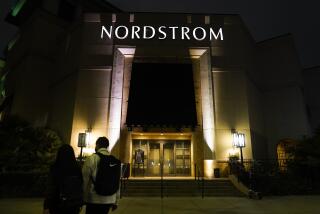Gap’s Founder to Step Down
- Share via
The founding generation of Gap Inc. is passing the torch.
Donald G. Fisher, 75, who started the company 34 years ago with one San Francisco store selling Levi’s jeans and record albums and watched it become the nation’s largest apparel retailer, said Tuesday that he would step down as chairman in May and turn the reins over to his 49-year-old son, Robert J. Fisher.
The father and son were instrumental in recruiting former Disney executive Paul Pressler to become Gap’s chief executive in September 2002, when the company was attempting to right itself amid sinking sales.
On Tuesday, Donald Fisher said the time was right to relinquish the chairmanship.
“Paul Pressler has done a terrific job in his first year as CEO and I’m more confident than ever about our company’s long-term prospects,” he said.
Donald Fisher and his wife, Doris, are the largest stockholders, owning 19% of Gap shares. Robert Fisher owns about 6%.
Gap’s outstanding shares numbered 895.9 million as of Dec. 2.
Donald and Doris Fisher will remain on Gap’s board. Donald Fisher will assume the role of founder and chairman emeritus and will stand for reelection as director when shareholders meet in May.
He will advise Pressler and Robert Fisher on “corporate strategy, governance and other matters,” the company said in a news release.
Robert Fisher worked in a variety of roles at Gap for 19 years, starting as a store manager. He served as chief operating officer and as president and chief financial officer of Banana Republic. In 1999, he resigned as president of the Gap division to “pursue personal interests,” the company said. He has been a director since 1990.
At Gap, Donald Fisher has been a steady force as it has gone through a wide range of changes over the years, expanding to a chain of 4,200 Gap, Old Navy and Banana Republic stores, said Dorothy Lakner, an analyst with CIBC World Markets who personally owns shares of the company.
“The image of the Gap has changed over time, but he’s been the constant,” she said.
The founder kept close tabs on the company’s stores, visiting them regularly, said Lakner, who last recalls seeing him at one of the three Gap stores in the World Trade Center.
“What I remember distinctly are the store people and associates, they all knew who he was,” she said.
Fisher -- who sports clothing from all three of the company’s brands -- was an entrepreneur who started the company with a $63,000 investment and turned it into a retailing powerhouse with $15 billion in annual sales, said Adrienne Tennant, an analyst with Wedbush Morgan Securities.
Although Gap does not have a mandatory retirement age for its directors or executives, Heather Brilliant, an analyst at Morningstar Inc., said it made sense for Fisher to retire, given his age and tenure.
“Overall, it seems reasonable that he’s handing it over to his son, who also has a big ownership stake,” Brilliant said.
Gap’s shares, which have gained 38% over the last year, fell 16 cents to $20.78 on the New York Stock Exchange. The announcement was made after the market closed.
Gap was born after Fisher tried to return a pair of jeans that didn’t fit and thought the local department store was too messy and offered too few sizes and styles.
Gathering a team that included his wife, Fisher decided to open a store where Levi’s would be organized by size instead of style and placed in cubicles on the wall, instead of on tables and racks.
They considered naming the store Pants and Discs, since records and tapes also were to be sold alongside dungarees in a bid to attract younger shoppers. But, mulling over the “generation gap” that was widening during the tumultuous 1960s, Doris Fisher suggested “The Gap” instead.
The first Gap store opened on Ocean Avenue in San Francisco on Aug. 21, 1969. Early ads boasted “three tons of Levi’s” in a single store.
“Fall into the Gap” was the slogan used during the 1970s.
Gap went public in 1976 and in 1980 began stocking clothes with its own label. It quit selling Levi’s in 1991.
Donald Fisher stepped down as chief executive in 1995. With legendary merchant Millard “Mickey” Drexler at the helm, Gap burnished its image as an icon of the casual crowd. For a time, it was a trendsetter in the apparel industry, with fashionistas eagerly awaiting the displays that would appear in its store windows. At one point, the brand held such cachet, actress Sharon Stone paired a Gap T-shirt with a floor-length black skirt and wore it to the 1996 Academy Awards.
Yet the company veered off course as the century turned, expanding too fast and trying to woo a younger, trendier customer. Hoping to revive flagging sales, Gap reversed course and returned to the basic apparel that had made it famous, including basic jeans, khakis, white shirts and T-shirts.
Still struggling in May 2002, Drexler announced his departure after 19 years with the company. That September, Pressler, who led Walt Disney’s $6-billion theme parks and resort division, was named Gap’s chief executive. Gap’s 29 consecutive months of declining sales ended October 2002.
Pressler has pumped up the company’s marketing, tried to improve its merchandise, and made customer service a high priority.
The turnaround appears to be gaining traction, analysts say.
Gap’s third-quarter earnings nearly doubled as TV ads, including those featuring singers Madonna and Missy Elliott, pulled customers into stores and improved operations turned sales gains into a larger profit.
“I think it’s clear from the last quarter that the company is definitely on the right track,” analyst Lakner said.
Gap’s November results also were encouraging. The company logged a solid 6% increase in same-store sales for the month, with all U.S. divisions posting increases and Banana Republic, its priciest chain, positing the largest gains, at 14%.
More to Read
Inside the business of entertainment
The Wide Shot brings you news, analysis and insights on everything from streaming wars to production — and what it all means for the future.
You may occasionally receive promotional content from the Los Angeles Times.










